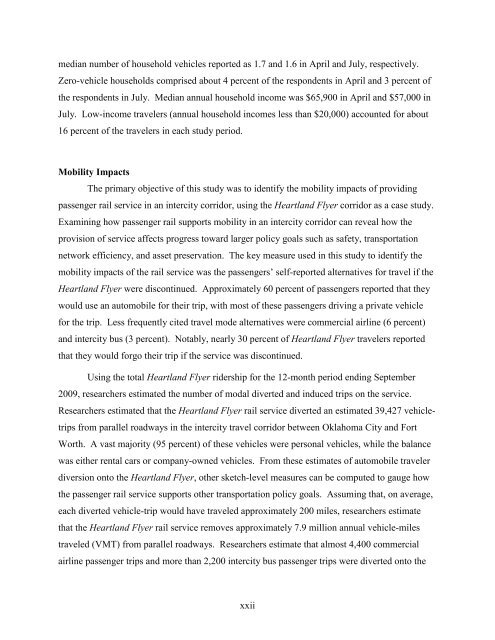Measuring the Benefits of Intercity Passenger Rail: A Study
Measuring the Benefits of Intercity Passenger Rail: A Study
Measuring the Benefits of Intercity Passenger Rail: A Study
You also want an ePaper? Increase the reach of your titles
YUMPU automatically turns print PDFs into web optimized ePapers that Google loves.
median number <strong>of</strong> household vehicles reported as 1.7 and 1.6 in April and July, respectively.<br />
Zero-vehicle households comprised about 4 percent <strong>of</strong> <strong>the</strong> respondents in April and 3 percent <strong>of</strong><br />
<strong>the</strong> respondents in July. Median annual household income was $65,900 in April and $57,000 in<br />
July. Low-income travelers (annual household incomes less than $20,000) accounted for about<br />
16 percent <strong>of</strong> <strong>the</strong> travelers in each study period.<br />
Mobility Impacts<br />
The primary objective <strong>of</strong> this study was to identify <strong>the</strong> mobility impacts <strong>of</strong> providing<br />
passenger rail service in an intercity corridor, using <strong>the</strong> Heartland Flyer corridor as a case study.<br />
Examining how passenger rail supports mobility in an intercity corridor can reveal how <strong>the</strong><br />
provision <strong>of</strong> service affects progress toward larger policy goals such as safety, transportation<br />
network efficiency, and asset preservation. The key measure used in this study to identify <strong>the</strong><br />
mobility impacts <strong>of</strong> <strong>the</strong> rail service was <strong>the</strong> passengers’ self-reported alternatives for travel if <strong>the</strong><br />
Heartland Flyer were discontinued. Approximately 60 percent <strong>of</strong> passengers reported that <strong>the</strong>y<br />
would use an automobile for <strong>the</strong>ir trip, with most <strong>of</strong> <strong>the</strong>se passengers driving a private vehicle<br />
for <strong>the</strong> trip. Less frequently cited travel mode alternatives were commercial airline (6 percent)<br />
and intercity bus (3 percent). Notably, nearly 30 percent <strong>of</strong> Heartland Flyer travelers reported<br />
that <strong>the</strong>y would forgo <strong>the</strong>ir trip if <strong>the</strong> service was discontinued.<br />
Using <strong>the</strong> total Heartland Flyer ridership for <strong>the</strong> 12-month period ending September<br />
2009, researchers estimated <strong>the</strong> number <strong>of</strong> modal diverted and induced trips on <strong>the</strong> service.<br />
Researchers estimated that <strong>the</strong> Heartland Flyer rail service diverted an estimated 39,427 vehicletrips<br />
from parallel roadways in <strong>the</strong> intercity travel corridor between Oklahoma City and Fort<br />
Worth. A vast majority (95 percent) <strong>of</strong> <strong>the</strong>se vehicles were personal vehicles, while <strong>the</strong> balance<br />
was ei<strong>the</strong>r rental cars or company-owned vehicles. From <strong>the</strong>se estimates <strong>of</strong> automobile traveler<br />
diversion onto <strong>the</strong> Heartland Flyer, o<strong>the</strong>r sketch-level measures can be computed to gauge how<br />
<strong>the</strong> passenger rail service supports o<strong>the</strong>r transportation policy goals. Assuming that, on average,<br />
each diverted vehicle-trip would have traveled approximately 200 miles, researchers estimate<br />
that <strong>the</strong> Heartland Flyer rail service removes approximately 7.9 million annual vehicle-miles<br />
traveled (VMT) from parallel roadways. Researchers estimate that almost 4,400 commercial<br />
airline passenger trips and more than 2,200 intercity bus passenger trips were diverted onto <strong>the</strong><br />
xxii
















